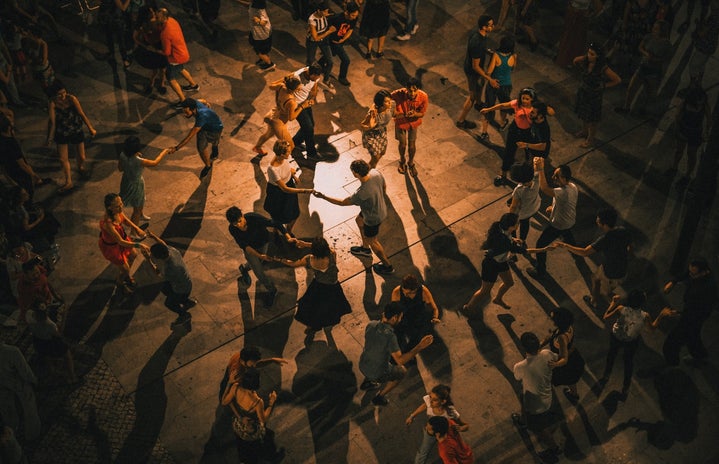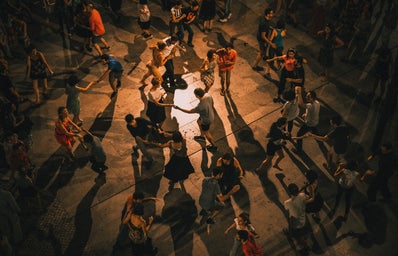Dance has always been present in my life. As long as I can remember, my free time was always spent twirling away in some studio. The most important thing I’ve learned from many years of pliès and pirouettes is that dance is not limited to just dancers. Dance is meant to be fun and is for everybody to enjoy! As a professional dancer, I’ve experienced that some dance forms, like ballet for example, have very strict requirements on how your body should be aligned and how you should execute movement. Unfortunately, this strictness can discourage people from wanting to try dance out, as well as hurt the confidence of an experienced dancer. I used to be an extreme perfectionist when it came to dancing—every movement had to be exact and precise. Nitpicking at everything from my weight to the height of my arabesque didn’t help me move forward in my dance career. Instead, it made me not only feel anxious every time I had to go to class, but want to quit dancing altogether. Dancing at parties or alone in my room always boosted my mood, but then I couldn’t even do that without my own criticism. After years of internal turmoil, something changed my dancing days for the better. I moved to NYC and instead of going to advanced or by-invitation-only classes reserved for the most elite dancers, I signed up for classes that simply looked fun. If you are a dancer who notices the limitations and the picture perfect minimum the professional dance world often puts on you, then these classes are perfect for putting the fun back into your craft. Furthermore, if you are a non-dancer who wants to try something new but are worried about your ability doing so, these will help you learn dance basics without any embarrassment.
- Zumba.
-
I love Zumba because you can’t tell how hard you’re actually working. This style is an intense cardio workout, but you’d never know because you get lost in its party-like atmosphere and super fun dance steps. Zumba incorporates elements of cumbia, merengue, salsa and bachata that work the core, arms, legs and stamina. I also like that you don’t have to stop dancing for the instructor to teach you steps or a combination. In Zumba, you dance non-stop because the moves are easy to pick up and feel natural on the body—just like how you’d feel on the dance floor at a nightclub. Zumba is perfect for beginners because it’s meant for each person to bring their own style and interpretation to the movement. Zumba doesn’t require you to know any fancy steps. You just have to know how to have fun!
- Masala Bhangra.
-
Like Zumba, Masala Bhangra is a dance you follow along with the instructor, except rather than incorporating Latin dance, it’s inspired by Indian dancing. Masala Bhangra fuses together Bhangra and Bollywood dance and Dhol Drum beats. This dance was created by fitness instructor Sarina Jain, who wanted to combine her culture with fitness on a worldwide level. The result was a high-energy Indian dance fitness that challenges you to use your masculine and feminine sides through movement. This is perfect for anyone who wants to learn Indian dance basics while working up a sweat.
- Samba no pé.
-
If you’ve ever heard of the Carnival of Brazil or have seen girls dancing in colorful, feather costumes, then you probably know about Samba. There are a couple different forms of Samba, but my favorite so far is samba no pé, or samba in the foot, which is a solo dance performed at the Carnival of Brazil. Women will dress up in stunning feather headdresses and costumes adorned with sparkles and beads, and then they will dance through the streets like a parade. There are also samba performances, competitions and, thankfully, classes. In a Samba class, you’ll learn the basic samba step, which is all about footwork. The basic step is moving one foot behind the other and then incorporating your hips into the movement to create a down-up-down motion within the lower body. You’ll learn combinations that use this step alongside fast footwork and lots of lower body and hip movement. Once you feel comfortable, a big part of samba is also about freestyling, and you’ll have the chance to show off your moves in a supportive, fun environment. Samba is great for helping people that say they have two left feet find their right foot. Also, if you play sports like soccer, it’ll aid in the agility and quickness of your transitions. If you want to feel sexy and learn a dance that’s a big part of Brazilian culture, then Samba is perfect for you. Once you get a hang of the intricate footwork, it’s hard to stop—you’ll want to samba all day!
- Salsa.
-
Salsa is perfect if you want to meet new people due to many nightclubs hosting salsa nights, as well as salsa often being a partner dance. This Latin dance form incorporates many hip movements, weight changes and specific rhythm and footwork. It will also help you learn how to dance with a partner and get in sync with your sexy, sensual side.
- Barre.
-
Barre is a fitness class inspired by the barre section of a ballet class, which is a warm up for ballet dancers so that they can correctly master ballet technique. Although barre isn’t a party-like cardio dance like the others I’ve mentioned, it’s great for beginners as well as experienced dancers who want some extra training. Barre will teach you ballet positions and help you achieve better posture and proper alignment for ballet and everyday life. If you already practice ballet, it’ll help strengthen muscle groups that a regular ballet barre won’t. Barre also lengthens and stretches your muscles, rather than making them “swole” and compact so that your muscles are defined in a way that fits your natural body. You’ll leave a barre class feeling a little bit taller, flexible and very sore.
- West African.
-
Depending on the country, there are many different styles of West African dance. However, this dance form can be fairly universal because West African dance consists of many specific dances. In other words, everyone in America knows how to do the Cupid Shuffle. Similarly, everyone in parts of West Africa knows how to do Sinte or Kuku. In a West African dance class, you’ll not only learn the basic moves, but you’ll also learn the steps to actual, popular West African dances. These dances are often performed in a group setting, usually within a circle, and are meant to last for hours. Many people will use movements from the specific dances and create their own unique freestyle. West African dance is very much like a party. There are group dances, battles, solos and people just having fun and cheering each other on. The accompaniment is also very important. A good West African dance class will always have a drummer, who is meant to sort of “control” the dance. The drummer will know all the specific dances and will give musical cues of when to start and stop each section. It’s super invigorating to move to live accompaniment! West African dance teaches you to move from your soul and from the external rhythms around you—it’s all about bringing your internal energy out onto the dance floor while your movements match the steady drum beat. If you’re naturally stiff or struggle with letting go while dancing, then West African dance is right for you because it will teach you to MOVE!
Dance is a fun way to stay active and exercise. It can also teach you about different cultures, as well as introduce you to different dance styles. Don’t be embarrassed and don’t worry about looking silly. Dance is whatever you want it to be— the only requirement is to have fun!


